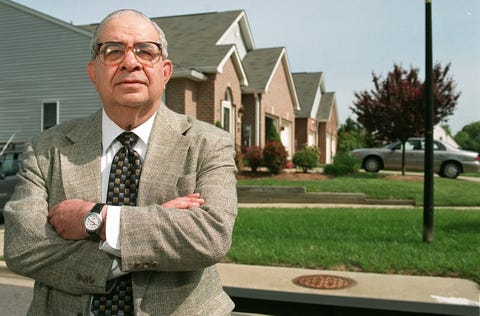How the Witness Protection Program Decides Where To Send People
Are witnesses ever relocated somewhere cool? Or just the middle of nowhere?

GETTY IMAGES/GREG WHITESELL
Gerald Shur, the retired founder and longtime head of the Federal Witness Protection Program, poses for a portrait May 6, 2002 at an undisclosed suburban location.
The U.S. Federal Witness Protection Program, also known as the Witness Security or WITSEC Program, tries to stash you where you’ll blend in, whether that’s Portland, Oregon, Portland, Maine, or anyplace in between. Thriving cities and sunny beach towns are definitely possibilities, depending on who you are.
“If you’re relocating [a witness] from New York City, you wouldn’t send them to a town in Texas with a population of 70 people,” says Gerald Shur, a former Justice Department attorney who founded the Witness Protection Program in 1971. “You’d try to relocate them to a place where they’d be comfortable, where you can get them employment and take care of their health needs. And of course the first thing is safety.”
"THE FBI HAS BUSINESSES—IT’S CALLED BACKSTOPPING."
The system seems to work, by the way, so long as you follow the rules. According to the U.S. Marshals Service, which administers WITSEC, while about 18,865 witnesses and family members have been relocated since the program’s inception, “no Witness Security Program participant, following program guidelines, has been harmed or killed.” Note the embedded qualification: following program guidelines. What that means exactly is anybody’s guess—neither the Department of Justice nor the Marshals Service is eager to dispense any detail on the program’s inner workings, which seems reasonable enough. You never know who might be reading a magazine like Popular Mechanics, studying up on shovels or cement. Still, we can piece together how it works in general—and speculate a bit to fill in some gaps.
Once a witness is relocated under an assumed name, their primary point of contact is a special U.S. Marshal known as a Witness Inspector, who helps them ease into the new location, likely assisting in establishing a credible-yet-concocted “history” for them through the sorts of front companies and other bogus entities that undercover federal agents use to appear legitimate. In an interview on a true-crime podcast last year, retired FBI agent Bobby Chacon speculated as much: “The FBI has businesses—it’s called backstopping. It’s a private business that’s been in existence for many years. That’s who provided me, when I was undercover, with my employment history and credit reports and stuff like that. I’m sure the marshals have something similar.”
Judging by the, ahem, evidence, most folks do fine in WITSEC, wherever they’re sent. Though 95 percent of those relocated are criminals, only 10 percent re-offend, an admirably low recidivism rate. And despite what must be the stress of disappearing into a new life, the dropout rate is reputedly low, though one famous participant, Henry Hill of Goodfellas fame, was booted after seven years and went on to open a restaurant in West Haven, Connecticut—which, you may be unsurprised to learn, promptly burned to the ground. Presumably he was not “following program guidelines.” One final tip: If you’re angling for a new life in Hawaii, whatever you do, don’t request it. When Shur ran the program, he’d ask witnesses where they wanted to go, under the theory that they might name destinations where they had ties or in which they might have previously expressed interest. “Every place they gave me, that’s where I wasn’t sending them,” he says. So best, perhaps, to ask for Omaha and hope for Honolulu.
No comments:
Post a Comment